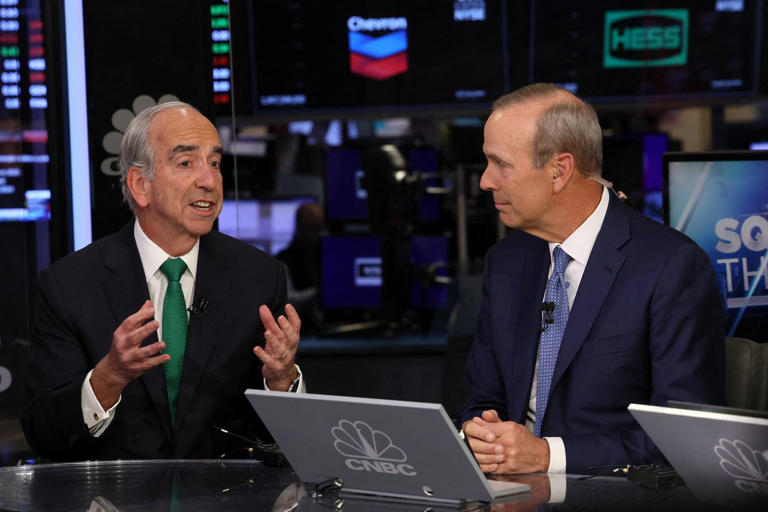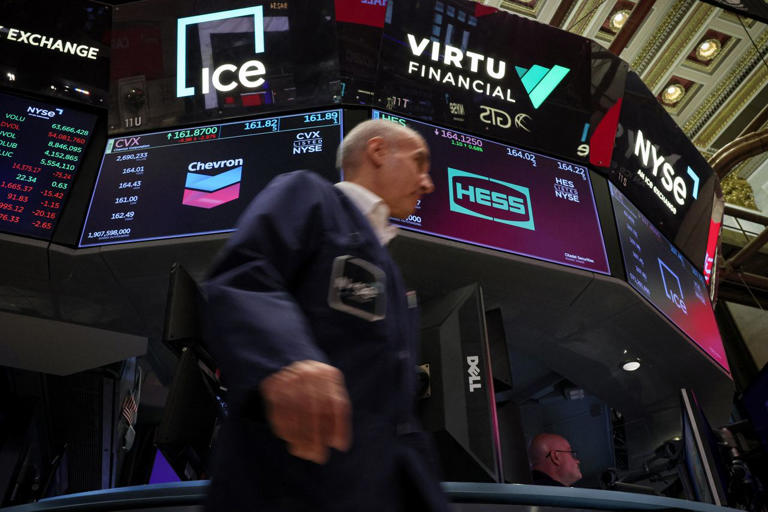An American Family Oil Dynasty Ends as Hess Sells
One of the first things you notice when entering the Hess Tower in downtown Houston is the original forest-green truck that Leon Hess drove around New Jersey nearly a century ago to deliver fuel.
Now, the Hess name is set to disappear from the ranks of the world’s prominent oil companies. Chevron on Monday said it would acquire the family company for $53 billion, concluding a 90-year saga bookended by the gruff founding father and his gregarious son, current Chief Executive John Hess.
The merger marks the end of an era as Hess was the last major U.S. oil company controlled by a single family. The enterprise was a throwback to the great family dynasties that propelled American industry, including the Rockefellers and the Gettys, and the luxury and glamour that accompanied them.

An American Family Oil Dynasty Ends as Hess Sells© Provided by The Wall Street Journal

The Hesses transcended plebeian roots to ensconce themselves in Manhattan and the Hamptons. Their oil empire afforded them the perks of outrageous wealth: private jets, Bahamian vacations, luxury real estate and, for a time, owning the New York Jets.
The dynasty has loomed large over the oil patch since 1933, when Leon Hess got tired of lugging bags of coal and started distributing heating oil. Walking in the footsteps of John D. Rockefeller’s Standard Oil, he built a fuel-marketing business that covered the East Coast with Hess-branded gas stations. He also ran what was once the world’s largest refiner
In the following decades, the company dotted North Dakota with rigs during the shale boom, drilled in the Gulf of Mexico and helped uncover one of the biggest oil fields in South America.
John Hess, 69, had hoped for his son Michael to take over the business as recently as 2013, but at some point dropped those plans, according to people familiar with the matter. Michael was cultivating other interests beyond the family business and pursuing a career in finance at top firms. Recently, the CEO hadn’t anointed a successor and was prepared to remain at the helm of the company for years.
Michael Hess couldn’t be reached for comment.

In 2013, hedge fund Elliott Management pushed for a board overhaul and a split of Hess into an international and a domestic company, among other changes. It eventually reached a settlement that saw Hess appoint three Elliott nominees on its board, and John Hess relinquish his chairmanship—a heavy price to pay for the dynasty’s survival.
“Many people would say, ‘Oh, well, they won’t want to sell their business because that’s the Hess name, it’s the Hess company,’ ” Marc Lipschultz, a director on the company’s board, said of Hess’s deal with Chevron. “He said, ‘OK, it’s the right strategic thing to do.’ ”
John Hess told employees this week that the merger would allow Hess to combine its growing oil resources with Chevron’s sturdy balance sheet and diverse assets.
“My father always believed that there was something noble about a business that could create jobs for people,” he said during a companywide meeting. “I just want you to know a lot of thought has gone into this.”
Similar to the Rockefellers, the Hesses suffered near-fatal business wounds over the years and decided to spin off their prized retail segment. But they maintained a 9.5% stake in the company, the value of which has soared to more than $4 billion—close to double what it was a decade ago.
The family’s influence radiated from the East Coast, where around Christmastime loyal fans lined up at Hess gas stations to buy the company-branded toy trucks. The toys are held in special reverence by the family: John Hess is personally involved in the design of each new model, as his father was. All the models produced since 1964 are on display at the company’s New York offices.
By age 7, John Hess was being groomed for succession, accompanying his father to foreign oil outposts. During that period, Leon Hess, who served as a petroleum supply officer in World War II, built what became the world’s largest refinery in the U.S. Virgin Islands and merged the business with Amerada Petroleum to form Amerada Hess.
The elder Hess wildcatted in search of oil from Alaska to the North Sea, rubbing shoulders with heads of state as he built his empire. To a guest visiting his art-filled Manhattan apartment, he reportedly once showed a Rolodex card with the phone number of Iran’s Ayatollah Khomeini on it.
A press-shy businessman, Leon Hess became a celebrity to New Yorkers as the owner of the Jets. He became a partial owner of the football team in 1963 before buying it outright in 1984. Despite the franchise’s years of mediocrity, his devotion remained intact. On Thanksgiving Day, the tycoon would attend practice in a folding chair, wearing a knitted green Jets hat.

In 1995, 40-year-old John Hess took over as CEO. He had learned the business from the ground up, pumping gas at 16 and joining the board in his early 20s. He studied at Harvard, where he was eager to learn about oil and geopolitics, said Daniel Yergin, the vice chairman of S&P Global, who met him during a seminar on Middle Eastern oil there.
“He wasn’t ghosting through, he was there to learn about this stuff,” said Yergin, an energy historian. Years later, Yergin would attend energy conferences alongside the oilman and watch as he conversed with Middle Eastern ministers in Arabic, which Hess speaks fluently.
Under John Hess’s leadership, the company forayed into new offshore frontiers and started drilling into shale-rock formations in North Dakota. But it suffered some costly misses in Indonesia, Brazil and Texas, and analysts said the company was spreading itself thin. Hess’s lagging share price gave an opening to activist investor Elliott Management.
After Elliott’s intervention in 2013, Hess shed more than $10 billion worth of assets—including its gas stations—to raise cash and become a nimbler player focused on a few large oil-and-gas projects, such as North Dakota’s Bakken Shale.

John Hess got a reprieve in 2015, when Exxon announced an oil discovery off the shores of Guyana, in South America. Hess had staked a 30% interest in the exploration project, which was later estimated to hold about 11 billion barrels of oil and gas, the largest modern oil find.
But the share price languished and Elliott came charging back in 2017, saying the company should get leaner and buy back more stock. It sought to oust John Hess, saying he had amassed a two-decade record of middling performance. Hess headed off a potentially mortal proxy fight when the company agreed to purchase additional shares.
In the years since, the company’s stock skyrocketed as Guyana has taken off, vindicating the CEO’s strategy to funnel cash from its Gulf of Mexico and Malaysia assets to grow in the Bakken and develop the offshore enterprise. Hess’s stock hit a record high around $166 in the days before the deal.
John Hess had previously discussed a potential tie-up with Chevron CEO Mike Wirth, but Hess’s valuation wasn’t high enough for a deal to happen, people close to him said. Talks picked up pace in the last six months, leading to an agreement for Chevron to buy Hess for $171 a share based on Chevron’s closing price last Friday. John Hess will join Chevron’s board.
“The activist attacks by Elliott, if they had been successful, would have left shareholders with far less than they’re getting in the Chevron transaction,” said Martin Lipton, a founding partner of law firm Wachtell, Lipton, Rosen & Katz and a longtime Hess adviser.
Elliott Management declined to comment.
On his desk, Lipton keeps a version of the first toy truck made by Hess and last year’s model. The dynasty may disappear, but fans will be able to keep collecting the toys introduced by the elder Hess. “The tradition will continue,” John Hess said in an interview this week. “In fact, next year is the 60th anniversary. I already know what the model is, but I can’t tell you.”
Bradley Olson and David Benoit contributed to this article.
Write to Benoît Morenne at benoit.morenne@wsj.com
No comments:
Post a Comment